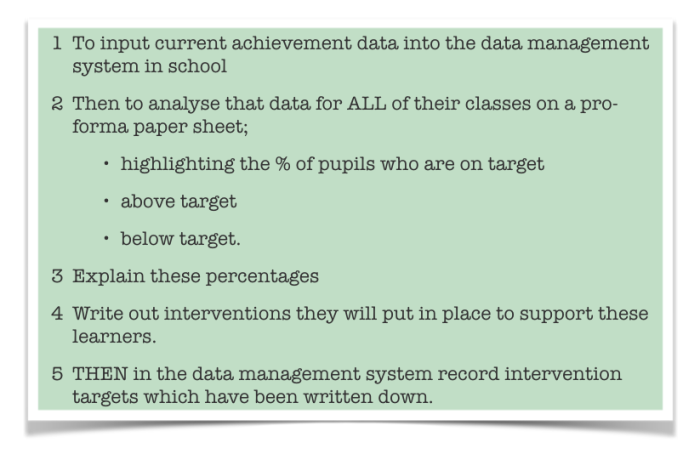Visual Management for school improvement
It’s a little bit more than colour coding, but that’s a good start on the road to improved productivity!
History – My father is a productivity/manufacturing consultant (cue “boo hiss”) but (and yes I’m a bit bias) he’s a damn good one; he knows his stuff and he does it because of his skill set, not his ego!
His ‘thing’ is visual and process management (6Sigma, LEAN Manufacturing). I’ve grown up hearing all about how to improve production/management processes in some of the biggest companies in the world (trust me, you’ll have products in your house that he’s been involved in).
Over time this has sunk in with me and now I’ve started to identify ways schools can apply methodologies which have made multinational companies successful!
My father works on two fronts in companies –
- On the ground floor looking at manufacturing processes
- At the senior and middle management levels to improve what we’d call ‘admin’ processes.
One activity he does on production lines which brilliantly illustrates how you can improve productivity, is applying simple changes focused on organising work space to improve work flow. Often, things as simple as “well if this box of screws was always on your right you wouldn’t get up, walk across the room and collect the items you need every 5 minutes would you?“ – simple, but you’d be impressed at the impact a tiny change like that can have on productivity!
This is what I want to improve in education – our productivity – by changing some big things, but most commonly the little things which slow down or even hinder productivity all together.

Teacher workloads are always a concern for the profession, as is the scrutiny of Ofsted, and often those two clash!
New policies and procedures can inadvertently send staff workload through the roof, and morale through the floor!!!
However being realistic, we may not like it but, there are hoops we have to jump through and that’s not just the teaching profession. Sometimes the ‘Ofsted induced panic‘ can mean that things are introduced and not thought through from an impact on productivity perspective. At their worst they become counter productive to achieving their intended aim!
School Data and productivity
Data is often an area that throws up the most productivity issues.
SMART use of data can make an organisation highly effective, giving it laser like focus on its progress and ability to act quickly and appropriately. But it can also become a productivity crusher, slowing and even stopping productivity by being an ineffective and inappropriate burden to a process, instead of an effective ally.
Let me illustrate my point with this example:
Imagine that leadership staff are made aware that they need to show Ofsted how data is being used by teachers to help them effectively plan lessons and support learners progress.
To achieve this they ask the following of every teacher in school…

Read that process through and ask yourself what is most important in that process?

Productive action…
To improve productivity you need teachers to do those two things as quickly as possible! So anything that lengthens that process should be viewed with a critical eye and removed if it can be!

Imagine how quickly you’d get designing interventions if you were given the data you need like this?
I present you with two options;
- Teachers are given a spreadshsheet with ALL of their classes data on and asked to calculate the percentages listed above and then identify and record interventions.
or
- Teachers are given class by class visualised data: colour coded pie charts showing % groups and accompanying colour coded students names (green for above target, amber for on target, red for below target). Teachers write their interventions directly into the management information system based on this pre-analysed data.
Which makes for a more productive teacher and more effective/faster school, don’t you think?
——————————————————-
This is a huge issue in schools. More so as pressure on the profession from outside mounts! The workload committee has locked its doors and we don’t really know when (or if) we’ll ever be given some solutions to the workload problem from them.
Schools need to address productivity themselves.
My suggestion is that schools begin to think creatively about employing the productivity and start applying the approaches of successful businesses NOW!
Consider bringing someone in from outside to review your processes and productivity (even a none-educationalist)!
Start looking at workflow and productivity yourselves. Give a member of staff a whole 1/2 term to focus on just that, and report back with clear actions which could help ease the workload of teachers and improve organisational productivity straight away.
Do it now before backs are up against a wall and you start implementing processes which impede your progress rather than support it!

Innovative schools will do this. They’ll recognise that if teachers can work SMARTER, then the organisation will improve. If you free up time in areas you create the opportunity to focus attention on practices which most effectively raise achievement – better teaching, better feedback and assessment.
Those three key areas shouldn’t be squeezed by pointless administration, they should be supported and made more effective by highly productive practices and policies which are continually reviewed to maintain their relevance!


